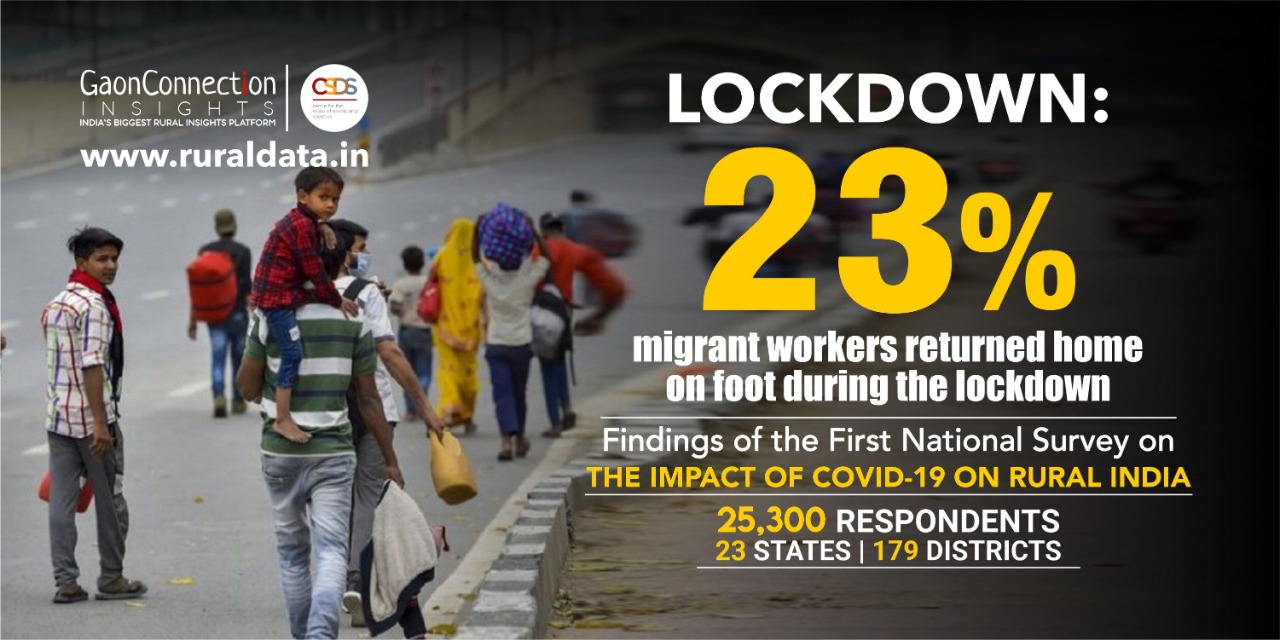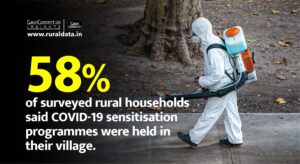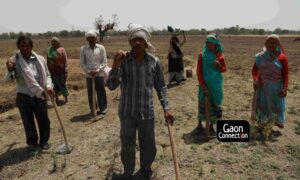Aarti, just two years old, was returning to her village in Hamirpur district in Bundelkhand from Narela in Delhi with her parents. By the time she reached Chattarpur, the border district where Madhya Pradesh and Uttar Pradesh meet, her tiny feet gave up. Her father Dharmendra said the family travelled for three days, in buses, trucks, and by foot. Since it was difficult for him and his wife to carry Arti always, they made her walk too, from time to time.
This incident is from May 17, 2020, the time when hoards of migrant labourers started walking to their village homes because they failed to find adequate relief from the government, despite it being the third phase of the nationwide lockdown in view of the COVID-19 pandemic.
Millions of parents like Dharmendra had to subject their children to similar hardships during the lockdown. Gaon Connection interacted with thousands of such people as part of a first-of-its-kind national rural survey and asked them about their journeys.
According to the Gaon Connection survey, 23 per cent of migrant labourers had to travel on foot to return home. 18 per cent of them returned by bus, and 12 per cent by trains. There were 10 per cent migrant labourers who went to their villages by car (taxi, etc.), and 8 per cent hitched truck rides. 3 per cent of them returned on motorcycles and scooters, and another 3 per cent pedalled their way home. 7 per cent reached home by other means.
The survey was conducted between May 30 and July 16, 2020, in 179 districts of 23 states and union territories of the country by Gaon Connection Insights, the data and insights wing of Gaon Connection, India’s largest rural media platform. The survey had 25,300 respondents interviewed face-to-face, maintaining physical distancing. The survey was designed and data were analysed by the New Delhi-based Centre for Study of Developing Societies (Lokniti-CSDS). All the respondents were major earners of their households. 80 per cent of the respondents were male.
The survey findings have been put together in the form of a report –The Rural Report – by Gaon Connection. (For complete details, visit www.ruraldata.in).
The lockdown that came into effect on March 24, 2020, hit the migrant workers the worst. The abruptly-announced lockdown caught these daily-wage labourers off guard. In most cases, the contractors, companies, offices and people they depended on, abandoned them. The panic of the disease, the fear of job loss, starvation, and the police’s strict measures prompted the migrant workers to return to their homes, thousands of kilometres away. They took anywhere from two to 15 days to reach their village homes.
However, it is interesting to note that despite all the hardships, 74 per cent rural respondents said they were “satisfied” with the government’s handling of the COVID-19 pandemic. Around 44 per cent respondents said the Modi government’s attitude towards migrant workers during the lockdown was ‘good’, and 21 per cent said it was ‘very good’.
Parvati of Chhattisgarh’s Bilaspur district was one such migrant labourer. She moved to Lucknow, some 700 kilometres away, with her husband in search of a livelihood, but during the lockdown, she was forced to leave for Chhattisgarh by foot, with her infant, under the glaring summer sun of May.
“In March and April, we struggled to pay the rent. We had to leave when we couldn’t afford the rent any longer. Had we continued to live there, we would have died of hunger. It was better to walk and die on the road. We thought God willing, we would reach safe and sound,” Parvati told Gaon Connection.
Many of those who had set out afoot managed to return home while some perished on the way. On May 8, 2020, 16 labourers had died while sleeping on a railway track in Aurangabad, Maharashtra. The weary labourers slept on the railway track thinking it to be safe as passenger trains were not plying. However, a goods train crushed the unsuspecting migrants to death. Similarly, on May 16, 2020, 24 labourers were killed and dozens injured in a crash between two trucks in Aurraiyya district of UP. The victims of the incident were the labourers from Bihar, Jharkhand and West Bengal.
Many labourers succumbed to health complications due to the arduous walk. Among them was Ranvir Singh, 39, of Morena district of Madhya Pradesh. Ranvir used to deliver tiffins at a hotel in New Delhi. He set out to walk 300 kilometres to reach home when he lost his job. He collapsed and died by the time he reached Agra’s Sikandra after he walked 200 kilometres.
Seeing the hardships and pain of migrants in the lockdown, the public demanded government measures. The Supreme Court intervened, and in its hearing on June 5, 2020, the Supreme Court directed the government to make arrangements for the safe return of migrants from all the states within 15 days.
Gaon Connection, in its survey, asked the migrants why they had come to the city. 74 per cent migrants said they moved to cities looking for employment. Only 7 per cent moved to study and 19 per cent for other reasons.
In the year 1979, the Inter-State Migrant Labour Act was formed for the benefit of migrant workers. The law aimed at keeping a record of the migrants besides protecting their rights. But this law could not be effectively enforced in the states and this is why the 40-year-old law could not help the migrant workforce during the lockdown.
Legal remedies notwithstanding, when the migrant labourers, facing starvation and unemployment during the lockdown, took to roads to return home, they also had to endure the ire of the police and administration.
In the survey, 12 per cent of migrant labourers told about suffering police atrocities on the way back to their homes during the lockdown. Not only that, but 13 per cent of migrant labourers also said that police personnel and government officials had treated them harshly. 14 per cent of migrant labourers admitted to having been treated ill by the common people too upon their arrival at home. 40 per cent of labourers informed that they had to face a lot of difficulties in getting something to eat during their journey home.
“At first, I had wandered about in Ahmedabad, starving and then returned here on foot. I had little money to speak of and even the government didn’t help either and on top of that police had confronted us at numerous places with lathis (canes),” Ashok Kumar, a returnee from Ahmedabad told Gaon Connection. “If I had a smartphone, I would have clicked the photos to tell the world what was happening to the labourers at that time. I took 20-25 days to return home and did not get any help from the government,” he added.
The Gaon Connection Survey also revealed that more than 8 per cent of migrant labourers took longer than a week to reach their homes during the lockdown.
Those returning on foot had to endure great hardship and physical distress, while those who came by vehicles like trucks, cars or motorcycles had to spend a sizeable amount of money. The workers returning from Mumbai to Jharkhand had to spend up to Rs 8,000 each whereas many among those who returned from Bangalore and Goa had to spend as much as Rs. 10,000 per person. The money for such a journey was either paid from the personal savings or raised with a loan. The government did arrange transportation, but it was too late. The complicated registration process to avail government transportation also discouraged millions of workers from opting for.
The survey revealed that most of the returnees on foot during the lockdown had been the migrant labourers who had migrated within their own state. 22 per cent of such migrant labourers had covered the entire journey on foot. Migrant labourers returning from a different state on foot were 13 per cent.
A large section of returnees was forced to travel home with their complete household. It means a large population of the migrant workers had to walk home with their wives and children. As per the Gaon Connection Survey, 55 per cent of the returnees had travelled on their own whereas 39 per cent were forced to walk with their families. The survey also found that 49 per cent of the migrant labourers who returned with their families believed the lockdown was far too challenging while 40 per cent of those who returned alone believed the lockdown was very harsh.
It would not be wrong to say the suffering they underwent during the COVID-19 lockdown will be etched in their memory for a long time.



















